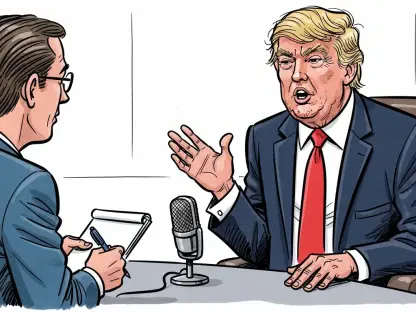In the heart of New York City, where academic excellence and activism frequently intersect, a campus finds itself embroiled in controversy. Can a prestigious university maintain its reputation for championing free speech while balancing the political pressures from the federal government? Columbia University, lauded historically for its support of student activism, has faced an intense backlash due to its newly adopted aggressive stance.
Balancing Academic Freedom and Compliance
The recent disruption at Columbia is underscored by a significant federal funding freeze that has left the university grappling with financial setbacks. This $400 million pause, initiated by the Trump administration, threatens a substantial part of Columbia’s operations, forcing the institution to rethink its governance approach. Such an extraordinary measure has placed Columbia under national scrutiny, emblematic of a larger clash between higher education institutions and government influence.
Columbia’s Changed Approach to Protests
Columbia’s decision to transition from dialogue-based protest management to involving law enforcement marked a seismic shift in policy. When student demonstrations erupted, the immediate call for NYPD intervention led to numerous arrests and suspensions, drawing immediate criticism. In comparison, Harvard University opted to legally challenge its federal funding freeze, a bold move that resulted in severe governmental pushbacks, yet sparked debate on methods of institutional resistance.
Diverse Perspectives on Columbia’s Actions
University officials have defended this assertive posture by citing the necessity to maintain safety and meet federal stipulations. However, student leaders and civil rights advocates argue this strategy undermines democratic values and silences student voices. Critiques center on the perception of Columbia’s willingness to bend to federal demands, eroding trust between the administration and the student body. Experts highlight the dangers of federal compliance exceeding academic freedom, a central concern for many academic institutions.
Charting a Path Forward Amidst Conflict
As universities tread this uncertain terrain, they must develop strategies that uphold safety without compromising student rights. Prioritizing dialogue and fostering inclusive communication can mediate tensions. Adopting frameworks that emphasize genuine engagement with student protesters may preserve the core democratic values educational entities are traditionally known for. The emphasis remains on finding equilibrium between adhering to governmental mandates and advocating for academic liberties.
In hindsight, Columbia’s recent history provides a complex case study of university governance during politically volatile times. While the funding dilemma tested the institution’s priorities, the future calls for a reflective approach that balances compliance with governmental expectations and the preservation of democratic principles and academic freedoms. The university community now stands at a crossroads, with the potential for setting precedents that might reverberate across academia.









